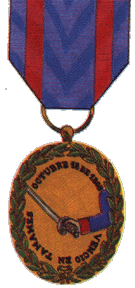The battle of Tamames (october 18, 1809)
 The battle of Tamames (18th October 1809) was the first Spanish battlefield victory in the Peninsular War since Alcañiz (23rd May 1809) and the only significant success during the Spanish Junta’s autumn campaign of 1809.
The battle of Tamames (18th October 1809) was the first Spanish battlefield victory in the Peninsular War since Alcañiz (23rd May 1809) and the only significant success during the Spanish Junta’s autumn campaign of 1809.
The Spanish General Don Diego de Cañas y Portocarrero, Duque del Parque, adavanced with a portion of his Ejército de la Izquierda (Army of the Left) advanced from Ciudad Rodrigo to Tamames, and took up a strong position on the hills above the village. His force comprised Maj-Gen Martin de la Carrera's Vanguard, Maj-Gen Francisco Xavier Losada's 1st Division, Maj-Gen Conde de Belvedere's 2nd Division, Maj-Gen Francisco Ballasteros's 3rd Division, Maj-Gen Marques de Castrofuerte's 5th Division and the Prince of Anglona's Cavalry Division. Altogether there were about 20,000 infantry, 1,400 cavalry and 30 artillery pieces.
The nearest French force was the weak 6th Corps at Salamanca, temporarily under the command of General Marchand.It comprised his own 1st Division (3 battalions each of 6th Light, 39th, 69th and 76th Line), Maj-Gen Maurice Mathieu's 2nd Division (3 bns. each of 25th Light, 27th and 59th Line, and 1 bn. 50th Line), Brig-Gen Jean Lorcet's corps cavalry brigade (3rd Hussars, 15th Chasseurs, 15th and 25th Dragoons). There were about 12,000 infantry, 1,200 cavalry and fourteen guns, so was significantly outnumbered, but other French armies had won victories over much larger Spanish armies. On 17 October Marchand left Salamanca, hoping to catch the Spanish. The next afternoon, when he arrived at Tamames, Marchand found the Spanish arrayed in line of battle, ready to fight.
Del Parque had posted his army on the hill above Tamames, with Losada’s division on the right, the steepest part of the hill and La Carrera’s vanguard division on the left, the weakest part of the line, with Belveder’s division in reserve behind La Carrera. The cavalry, under the Prince of Anglona, was posted to the left of the line, guarding the left flank of the army. Marchand quickly realised that the Spanish left was the weakest part of the line and decided to send one infantry brigade (Maucune) and most of his cavalry to attack La Carrera, while a second infantry brigade (Marcognet) attacked the Spanish centre. His third brigade (Labassée) was held in reserve.
The problem with Marchand’s plan was that he did not make his attack on the Spanish left strong enough. Maucune’s brigade saw off the Spanish cavalry, and managed to break through La Carrera’s division, but then came up against the intact Spanish reserves. Belveder’s men opened up to left La Carrera’s division pass though it, and then closed up to face the French. Maucune was outnumbered by three to one on ground that was unsuited to cavalry, and his attack came to a halt.
When Maucune broke through La Carrera’s division, the French launched their attack on the Spanish right, but with much less success. Losada’s division held its ground, and the French column came to a halt when it was only three quarters of its way up the hill. After standing and taking fire for some time, the French turned and fled. Losada’s men, supported by Spanish light troops from Tamames, launched a counterattack, which forced the French back onto their reserves, and then pulled back into their original position on the hills. Seeing the defeat of the French left, Maucune abandoned his vulnerable position and pulled back from the hillside.
Realising that the battle was lost, Marchand retreated back towards Salamanca, but then abandoned the city, and on 25 October Del Parque entered the city in triumph. The French had suffered 1,300 casualties, including 18 officers killed, a 12-pounder. The 76th also lost its eagle. The Spanish had only lost 713 killed and wounded.
 Spanish participants of the battle were later issued a badge reading Venció en Tamames, ([He] conquered at Tamames).
Spanish participants of the battle were later issued a badge reading Venció en Tamames, ([He] conquered at Tamames). More information
Ciudad Rodrigo. Sitio napoleónico
Batalla de Tamames
Battle of Tamames (wikipedia)
Military History Encyclopedia on the Web

































Sounds like am interesting battle. I have not yet built any Spanish forces, is this army very representative of the Spanish forces in the peninsular wars.
ReplyDeleteJohn
fuentesdeonoro.blogspot.com
Hi John
ReplyDeleteYes, the Spanish Army of this battle is representative of the Sapnish forces in the middle years of the Peninsular. There are a small core of veterans of the old Army, but the main army is made from recrutis.
Regards
Rafa
Interesting that the French lost an eagle to the Spanish forces. This goes against my impression that the Spanish Napoleonic army was fairly ineffective. Is this an unfair opinion?
ReplyDeleteIan
Ian
ReplyDeleteIt is not an unfair opinion... Spanish armies were in general no match for French armies in the Peninsular War, at least until 1812. There were some battles won by the Spanish, butthey were few and marginal (exception made from Bailen)
Regards
Rafa
Hi Rafa,
ReplyDeleteWhat figures will you use for the Spanish troops?
Regards,
Matt
Matt
ReplyDeleteI have not refight this battle. However, for Talavera (also in 1809) I did utilize Hat 8083 Prussian 1806 Line Infantry to depict the old 'regular' infantry, and any French shako style figure (ESCI,ITALERI...) for the 'new recruits'. For cavalry use ITALERI (REVELL) Prussian cuirassiers for the 'regular' and any other figure for the 'new' units.
You can see them at my web site
http://rafaelpardoalmudi.com/conversion.html
Regards
Rafa